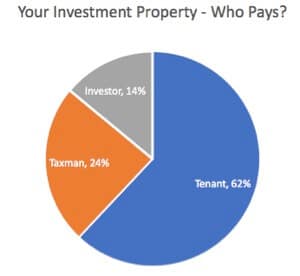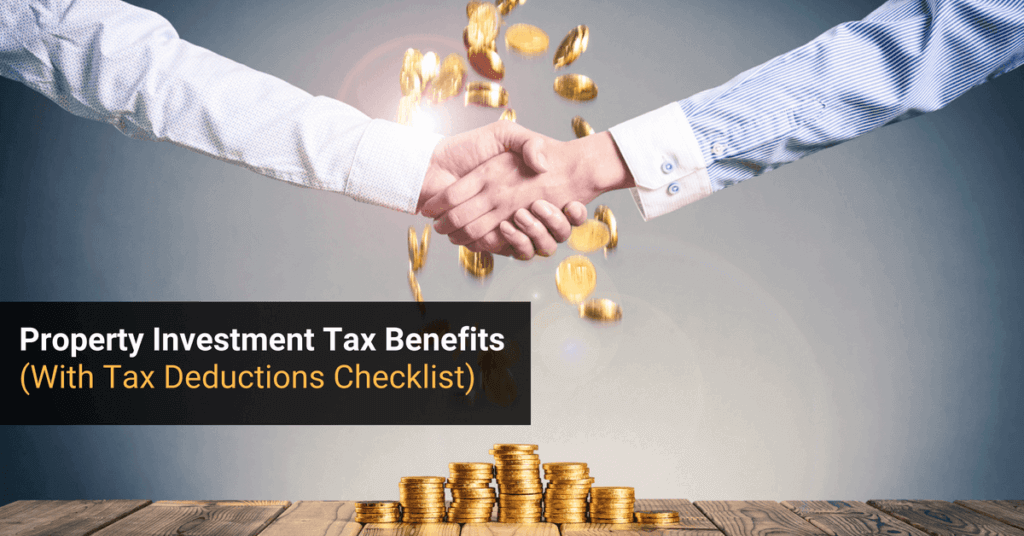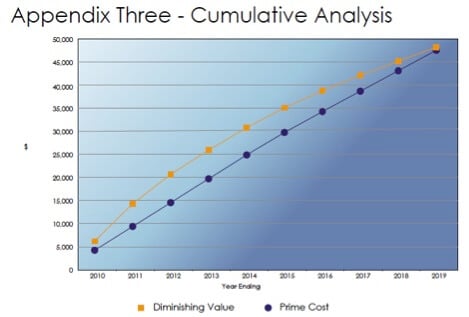Property investment tax benefits are far from the only reason to invest in property, but they are one of the key financial levers for property investors.
When high-flying businessman Kerry Packer was faced with charges of alleged tax evasion, he was infamously quoted as saying:
“I am not evading tax in any way, shape or form. Of course, I am minimising my tax. Anybody in this country who does not minimise his tax wants his head read. I can tell you as a government that you are not spending it so well that we should be donating extra.”
Therefore, tax optimisation is a critical area for property investors to master in order to ensure you take advantage of all the tax benefits to which you’re entitled.
In this article, we’ll explore the major tax benefits of property and how savvy investors can optimise their tax.
The Impact Of Property Investment Tax Deductions

Financial modelling tools such as PIA software includes an investment property tax calculator that illustrates exactly how much the taxman is contributing to the holding costs of your investment property.
It’s not unusual to see scenarios where the investor is only funding a small fraction of the property, with the taxman and the tenant funding the rest.
In the example here, the taxman is contributing 24% of the overall holding costs, leaving the investor to shoulder only 14% of the total costs.
Investment Property Tax Deductions Checklist: What Can I Claim?

- Loan Interest expenses incurred as a direct result of the purchase of a rental property, the purchase of a depreciating asset for the rental property (e.g. a new dishwasher), the cost of repairs, financing renovations for your rental premises or the acquisition of land on which to build rental accommodation.
- Prepaid loan interest: you can also claim a deduction on interest you’ve pre-paid up to 12 months in advance. This can be a useful way to bring a tax deduction forward into the current tax year if you have a particularly high-earning year that pushes you into the next tax bracket.
- Property management fees and expenses
- Rental marketing expenses
- Body corporate fees and charges
- Council rates
- Land tax
- Water supply charges
- Building, contents, public liability and landlord insurance
- Cleaning expenses
- Garden and lawn maintenance
- Repairs and maintenance: specifically, the cost of work undertaken to remedy defects in, damage to or deterioration of the property. For example, repairs such as fixing electrical appliances or replacing storm damaged roofing or guttering. Examples of maintenance deductions are things that will prevent future deterioration or address existing issues, such as painting the interior and exterior, or keeping the plumbing in good order. These are distinct from capital expenses (i.e. a renovation) – which must be depreciated – see below.
Important note re: claiming a tax deduction on loan interest: if you use a portion of your loan for any private purpose, such as buying a new car, you cannot claim interest on that portion of the loan. For this reason, loan structuring is paramount to ensure you keep investment expenses and private expenses clearly separated.
Repairs and Maintenance: What You Can Claim And When

If a repair or maintenance expense doesn’t directly relate to damage or wear and tear that occurred as a result of the premises being tenanted, then you are not allowed to claim the entire cost in the year you incurred these expenses
Likewise, improvements such as renovating the kitchen or bathroom are treated as capital expenses that can be claimed over a number of years in the form of depreciation deductions.
Buying And Selling Expenses

- Solicitor’s or conveyancing fees
- Building and Pest Report costs
- Valuation fees
- Buyer’s Agent fees
- Stamp duty
The same applies to any initial repairs undertaken on the property. These are effectively treated as part of the purchase costs.
The good news is: even though you can’t claim the above items on your annual tax return, you CAN claim these expenses when calculating Capital Gains Tax (CGT) when selling the property in future.
So you don’t miss out on this particular investment property tax benefit: you just have to wait a little longer.
Tax Deductible Legal and Mortgage-Related Expenses

- Costs incurred when evicting a non-paying tenant
- Court action taken for loss of rental income
- Defending a damages claim in respect of injuries suffered by a third party on your rental property
And just to complicate matters further, mortgage related costs such as loan establishment fees can generally be claimed over five years.
Claiming Depreciation As A Tax Deduction

Depreciation is an expense that can be claimed over a number of years. You can do this with both buildings and fixtures and fittings.
Capital works expenditure claims are generally spread across the life of your investment, with deductions permitted on dwellings where construction commenced after 17th July 1985, where the property is used to produce rental income.
Further deductions can apply to structural improvements made to parts of the property, other than the building, for any work commenced after 26 February 1992. Examples include construction of fences or retaining walls.
Claiming Depreciation On Buildings
Investors can claim depreciation on dwellings constructed after 17 July 1985. The building cost can be depreciated at a rate of 2.5% a year (or 4% if built between 18 July 1985 and 16 September 1987).
For investment properties acquired after 17 May 1997, the cost base must be reduced by the amount of depreciation you have claimed since owning the property. (The cost base is only relevant for calculating CGT when you sell an investment).
Depreciation Rules For Fixtures and Fittings
You can also claim a deduction for fixtures and fittings, due to their limited effective life span and the expectation of a decline in value over time.
These are things that came with the property or that you’ve added to the property while renting it out. Examples include:
- air conditioners
- garage door openers
- blinds
- carpets or floor coverings
- ceiling fans
- cooktops
- dishwashers
- door closers
- exhaust fans
- hot water systems
- ovens
- rangehoods
- solar power systems
- wardrobes
- washing machines
For assets that cost $300 or less, you can claim an immediate deduction for the entire cost, but any other depreciable items must be claimed over the time you hold the property in your portfolio.
Calculating the decline in value of a depreciating asset is tricky business. Most investors will simply engage the services of a Quantity Surveyor, who will do the heavy lifting for you. They’ll provide you with a report that can be supplied to your accountant at tax time, listing all the tax deductions you can claim.
The below graphic, which depicts the cumulative depreciation claimed on an older, established investment property, demonstrates how critical these entitlements can be to your cashflow position, with a combined deduction value of around $48,000 over ten years for this particular asset. That’s almost $5,000 per annum in tax deductions that could significantly reduce your tax bill.
Higher Depreciation Benefits For Brand New Property
Depreciation rules were changed in the 2017 Federal Budget, stipulating that investors can depreciate plant and equipment assets as long as the property is brand new.
However, subsequent owners cannot claim depreciation on existing plant and equipment assets, such as dishwashers and air conditioners.
Negative Gearing

Negative gearing definition:
According to the ATO: A rental property is negatively geared if it is purchased with the assistance of borrowed funds and the net rental income, after deducting other expenses, is less than the interest on the borrowings.
Although there has recently been a great deal of debate around negative gearing, for the time being, it’s here to stay.
A Simple Negative Gearing Example
John and Sally Investor buy an investment property that brings in $800 per week in rent, or $41,600 per year.
Because John earns a higher income than Sally, they decide to purchase the property in John’s name in order to maximise the tax deductions.
The total annual expenses to hold the property, including all interest costs, are $50,000, leaving John with a loss of $8,400 annually.
Using negative gearing, John is able to reduce is taxable income by that $8,400. Assuming he is paying tax at the top marginal rate of 47%, the actual out-of-pocket cost to John is only $4,452 per year.
Why would John make a loss for holding the property? Because he is betting on the value of his property increasing by much more than $4,452 ever year, delivering a net gain.
That’s negative gearing.
No Longer Tax Deductible: Investor Travel Perks

Whereas it used to be possible to claim travel expenses when visiting a rental property (even interstate), this is no longer the case
In Conclusion: Don’t Invest For Tax Reasons – Optimise Your Tax Instead

However, as part of a holistic property investment strategy, maximising tax deductions and optimising your tax position are crucial. To ensure you’re capitalising on these benefits, it’s imperative to keep good records of all transactions and expenses related to your property investments.
If building a tax-optimised investment portfolio is on your radar right now, request a free Investment Property Strategy Session, where we’ll answer your questions and customise our recommendations to suit your situation and objectives.


